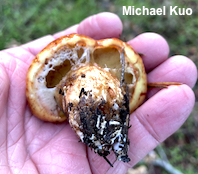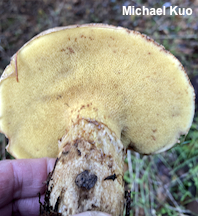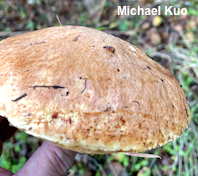| Major Groups > Boletes > Suillus > Suillus ponderosus |

|
[ Basidiomycota > Boletales > Suillaceae > Suillus . . . ] Suillus ponderosus by Michael Kuo, 22 January 2024 This bolete is a West Coast slimeball associated with Douglas-fir in coastal forests. It is fairly easily recognized—especially when young—by the orange gluten that covers the cap, stem, and partial veil. As the mushroom matures and the veil breaks, it forms a collapsing, glutinous ring on the upper stem. The epithet ponderosus refers to the large size of the species (it often gets much bigger than the collection featured here), rather than an association with ponderosa pine—a very different tree, not found in coastal forests. Description: Ecology: Mycorrhizal with Douglas-fir; growing alone, scattered, or gregariously; fall and winter; originally described from Oregon (Smith & Thiers 1964); distributed in coastal northern California and the Pacific Northwest. The described and illustrated collection is from California. Cap: 7–15+ cm across; convex when young, becoming broadly convex; covered with orangish gluten when fresh; bald; orange-brown to cinnamon brown; with white veil remnants on the margin. Pore Surface: Dull yellow; staining and bruising brownish; with 1–2 angular pores per mm; pores vaguely radially arranged; tubes up to about 1 cm deep; initially covered by a whitish veil that is coated with orangish gluten. Stem: 4–10 cm long; 2–3+ cm thick; more or less equal; dull yellow and reticulate above the ring; whitish to brownish or orangish brown below; ring whitish but often stained orangish to brownish from gluten, gelatinous, collapsing; glandular dots lacking or poorly defined; basal mycelium white. Flesh: Pale yellow; not staining on exposure, but sometimes greenish to bluish in the stem base. Odor and Taste: Not distinctive. Microscopic Features: Spores 7–10 x 3–4.5 µm; boletoid-fusiform; smooth; yellowish in KOH. Basidia 25–30 x 5–8 µm; clavate; 4-sterigmate. Cystidia in gelatinized bundles, often obscured by pigment globules; 25–50 x 4–8 µm; cylindric to clavate; thin-walled; smooth; brown in KOH. Pileipellis an ixocutis of elements 2–4 µm wide, smooth, hyaline to brownish in KOH. REFERENCES: A. H. Smith & H. D. Thiers, 1964. (Smith & Thiers, 1964; Thiers, 1975; Thiers, 1979; Smith, Smith & Weber, 1981; Arora, 1986; Both, 1993; Bessette, Roody & Bessette, 2000; Nguyen et al., 2012; Klofac, 2013; Desjardin, Wood & Stevens, 2015; Nguyen et al., 2016; Siegel & Schwarz, 2016.) Herb. Kuo 01112405. This site contains no information about the edibility or toxicity of mushrooms. |
© MushroomExpert.Com |
|
Cite this page as: Kuo, M. (2024, January). Suillus ponderosus. Retrieved from the MushroomExpert.Com Web site: http://www.mushroomexpert.com/suillus_ponderosus.html |


